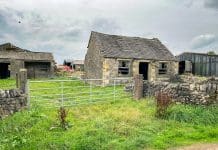One in 6 homes are now under threat of flooding from rivers, sea and surface water. BRE’s Centre for Resilience is calling for a new approach to dealing with the risks along with investment and the development of innovative technologies to improve flood resilience. Director of the Centre, Dr Stephen Garvin reports…
From weather bombs to hurricane Bawbag our climate is becoming ever more unpredictable and the threats to property and infrastructure significant.
Climate change may have significant implications for the built environment, with impacts likely on buildings, energy, transport, ICT and water infrastructure. Analysis from the UK Climate Change Risk Assessment (CCRA) indicates that the built environment will be affected by extreme weather events with flooding as one of the highest order of risks.
With this in mind BRE’s Centre for Resilience recently launched its flood resilience policy paper ‘A Future Flood Resilient Built Environment’ which calls on government to adopt a new approach for tackling flooding which is a risk to over 5 million homes in the UK alone.
In the past it was thought that a flood defence strategy could protect communities and individuals, and their property. Government recently announced £2.3bn spending on improving flood defences – this investment will protect 300,000 homes which is great. We also need a new approach to flood management to reduce the risks further as climate change and increasing urbanisation create greater exposure to flooding.
This should be based on resilience where we make space for water and adapt our infrastructure for the inevitability of flooding. Critical factors are investment in research and innovation to support this paradigm shift. The paper urges the government to think about the rise in surface water flooding, prevalent in urban areas as this requires a more adaptive flood management approach. Surface water management needs to be embedded in the new developments we construct with things like sustainable urban drainage systems, green roofs to decrease water run off as well as localised flood resilient technologies.
It raises questions about the thousands of new properties built each year in flood risk areas, increasing the overall exposure and vulnerability of the built environment. There are currently no building regulations and standards that adequately cover the design and construction of resilient buildings. Research and innovation in this area would result in the development of resilient buildings that meet high sustainability standards in other aspects. Current thinking needs to be converted into a series of demonstration and test sites to provide technical solutions that can be adopted by designers and builders.
The paper identifies the lack of effective guidance documents, tools, standards and certification schemes related to the resilience of the built environment, therefore the construction industry does not have the capacity and capability to provide effective resilience solutions for new and existing buildings. Education, training and CPD for designers, builders, product manufacturers and property managers is necessary. Dedicated resources should be put towards education in current courses, through to current managers and directors in the industry.
It explains how research and innovation on the management of water at neighbourhood/community to city level is required. BRE has carried out research on the LifE project which demonstrated potential sustainable master-planning opportunities, but further research and implementation is required to develop viable (economic, financial, social, technical and environmental) solutions. Discussions should take place on the need for a compulsory assessment of flood risk for all buildings in the UK. The opportunity for PLP and other flood resilience measures should be determined.
The aim of the White Paper is to encourage successful approaches that address existing and future developments in the built environment. Resilient solutions can be developed through research and innovation, but there is a need to address policy and practice in order for such solutions to be implemented. Things are already moving in the financial services sector, who move quickly in response to risks. One area of change is in the insurance sector, from 2015 the current approach, the ‘Statement of Principles’, will no longer apply and instead a scheme known as ‘Flood Re’ will be adopted. It will provide a fund to offer people at high flood risk who might otherwise struggle to get affordable flood insurance with cover at a set price. Insurers will put into the fund those high flood risk homes they feel unable to insure themselves, with the premium to cover the flood risk part of the household premium capped.
Customers should not notice any difference and will continue to be insured. However, the changes will result in a need for insurers to better manage their risk, especially for high risk areas. As a result investment in property level protection may need to be considered by owners, and at least better information on where such measures have been installed will be required.
Research by the University of Dundee for the Scottish government involved a survey that made a preliminary assessment of possible societal implications of the insurance change. A particular area of concern expressed by insurance industry representatives is that they have had difficulty to date in accessing information on improvements which may substantially reduce the flood risk for individual properties in a format that would enable those data to be used for commercial purposes.
On this point BRE is working with AXA Insurance and Lexis-Nexis on the difficulty of insurers accessing information on improvements to buildings to manage flood risk. The Property Flood Resilience Database (PFR-d) project is funded by Innovate UK and will result in the means to inform insurers of relevant measures that have been taken.
What the insurance industry is currently not able to take into account is the investment made by the insured and the government on protecting properties through implementing flood resilience. The project will be undertaken to develop a prototype, involving the gathering and sorting of information on Property Level Protection and resilience of buildings, it will develop the framework for the PFR-d (combining existing datasets with the new PFR-d) and will then pilot the process through a trial area in the UK. The white paper will be further presented to government departments throughout the UK, as well as leading industry organisations. A copy can be found at www.bre.co.uk/resilience
Dr Stephen Garvin
Director – Centre for Resilience
BRE
Tel: +44 (0)1355 576200
garvins@bre.co.uk













